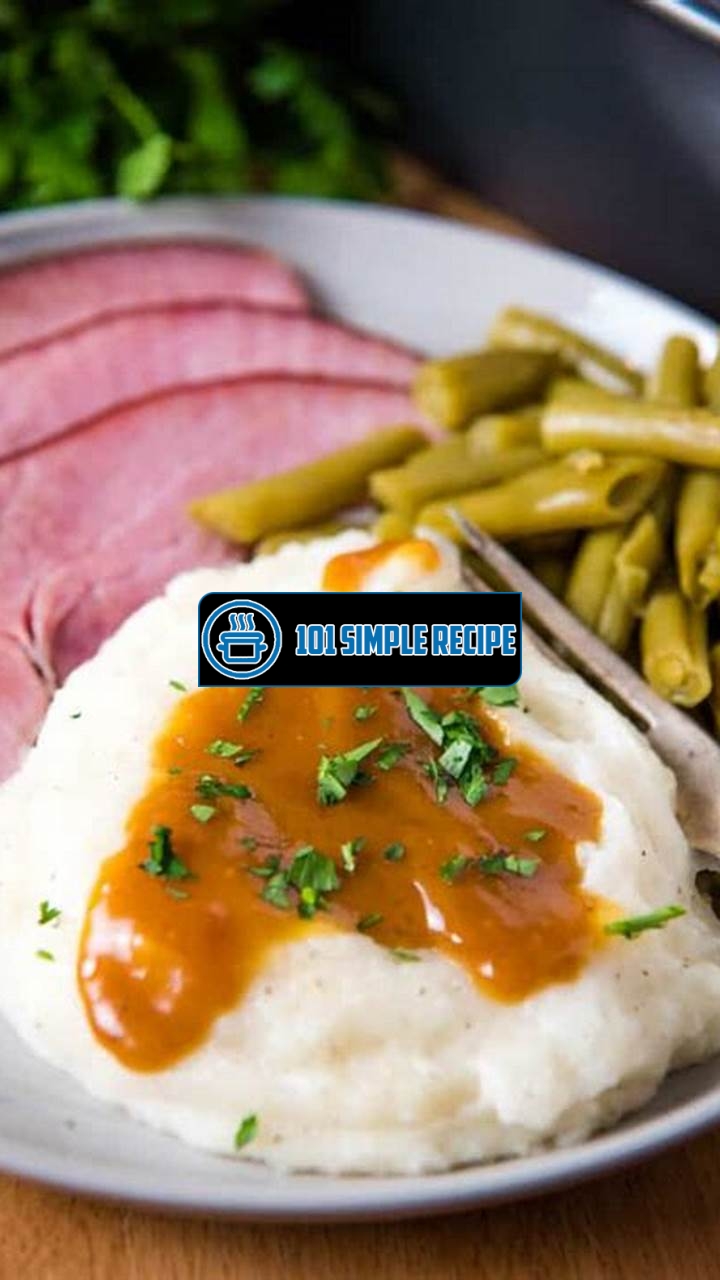Are you ready to elevate your ham dinners to a whole new level of deliciousness? Look no further than this guide on how to create mouthwatering ham gravy. ️ Whether you’re serving it with a classic baked ham, roasted pork, or even as a flavorful addition to your Thanksgiving feast, this savory gravy will undoubtedly become a favorite at your table. In this article, we’ll take you through the step-by-step process of making ham gravy from scratch, from selecting the perfect ham drippings to adding the right blend of herbs and spices. So, grab your apron and get ready to impress your guests with this delectable ham gravy recipe.

Understanding Ham Gravy
Discover the essentials of making delicious ham gravy to elevate your meals.
What is Ham Gravy?
Ham gravy is a savory sauce made from the juices and drippings of cooked ham. It is a versatile accompaniment that adds flavor and moisture to a variety of dishes.
Pro Tip: Ham gravy is typically served alongside ham dishes, such as baked ham or glazed ham, but it can also be used to enhance the flavors of other meats and vegetables.
Ham gravy is made by combining the pan drippings from cooked ham with a thickening agent, such as flour or cornstarch, and adding additional seasonings to taste. The result is a rich and flavorful sauce that pairs perfectly with ham.
Types of Ham Gravy
There are a few different types of ham gravy, each with its own unique characteristics and flavors.
1. Classic Ham Gravy: This is the traditional version of ham gravy, made by combining the pan drippings with a roux (a mixture of fat and flour) and adding broth or stock. This type of gravy has a rich, creamy texture and a robust, meaty flavor.
2. Sweet Ham Gravy: Sweet ham gravy is a variation of classic ham gravy that incorporates sweet ingredients, such as brown sugar, honey, or fruit juice. This type of gravy adds a touch of sweetness to the savory ham flavors, creating a delicious contrast.
3. Smoky Ham Gravy: Smoky ham gravy is made by adding smoky ingredients, such as smoked paprika, liquid smoke, or bacon, to the classic ham gravy base. This type of gravy adds an extra layer of depth and complexity to the dish.
Pro Tip: Feel free to experiment with different ingredients and flavors to create your own signature ham gravy. Add herbs, spices, or even a splash of alcohol for an extra kick of flavor.
Choosing the Right Ham
When it comes to making delicious ham gravy, choosing the right ham is crucial. Here are a few tips to keep in mind when selecting your ham:
- Quality matters: Opt for high-quality ham for the best results. Look for ham that is flavorful and not too salty.
- Consider the cut: Different cuts of ham will yield different flavors and textures. Choose a cut that suits your preferences and the dish you plan to make.
- Choose bone-in or boneless: Bone-in ham will add extra flavor to your gravy, but boneless ham works just as well.
- Check the label: Read the label carefully to ensure that the ham is free from added hormones, antibiotics, and artificial ingredients.
Pro Tip: If you don’t have access to pan drippings from a cooked ham, you can use canned ham broth or stock as a substitute. Just make sure to adjust the seasoning accordingly.
By understanding the basics of ham gravy and exploring different variations, you can create a delicious sauce that will take your ham dishes to the next level. Whether you prefer classic, sweet, or smoky flavors, ham gravy is a versatile and tasty addition to any meal.
Preparing the Ingredients
In order to create delicious ham gravy, it is important to gather and prepare the necessary ingredients. This section will guide you through the crucial steps to ensure that you have everything you need.
Measuring the Ingredients
The first step in preparing the ingredients for ham gravy is to measure them accurately. This will ensure that the flavors are balanced and the gravy has the perfect consistency. Here is a breakdown of the ingredients and their recommended measurements:
- Ham drippings: Measure approximately 1/4 cup to provide the base flavor for the gravy.
- All-purpose flour: Measure 2 tablespoons to thicken the gravy.
- Milk: Measure 1 cup to add creamy richness to the gravy.
- Salt and pepper: Add a pinch of salt and pepper to taste.
By measuring the ingredients accurately, you will be able to create a well-balanced ham gravy that will complement your main dish.
Preparing the Ham
Before adding the ham drippings to the gravy, it is important to prepare the ham properly. Follow these steps to ensure that your ham is ready:
- Cook the ham: Roast or bake the ham according to your preferred recipe. This will create the delicious flavors that will later enhance the gravy.
- Collect the drippings: Once the ham is fully cooked, remove it from the pan and let it rest. The drippings will accumulate at the bottom of the pan.
- Skim the fat: Carefully remove any excess fat from the ham drippings. This will result in a healthier gravy without compromising on flavor.
Preparing the ham beforehand ensures that you have the best possible base for your ham gravy.
Adding Flavor Enhancements
To take your ham gravy to the next level, consider adding flavor enhancements. These additions will elevate the taste and make your gravy even more delicious. Here are some options to consider:
- Onions and garlic: Sauté finely chopped onions and minced garlic in a separate pan before adding them to the gravy. This will infuse the flavors and add depth to the overall taste.
- Herbs and spices: Experiment with herbs and spices such as thyme, rosemary, or paprika to enhance the flavor profile of the gravy. Be sure to add them sparingly and adjust to your personal preference.
- Wine or broth: For an extra touch of richness, you can add a splash of white wine or chicken broth to the gravy. This will add complexity and depth of flavors.
By incorporating these flavor enhancements, you will create a ham gravy that is bursting with deliciousness.
Creating delicious ham gravy requires careful preparation of the ingredients, accurate measurements, proper ham preparation, and the addition of flavor enhancements. By following these steps, you can elevate your gravy-making skills and ensure that your ham dish is a success. So roll up your sleeves, gather your ingredients, and get ready to create a delectable ham gravy that will leave everyone asking for seconds!
Cooking the Perfect Ham Gravy
Master the cooking process to create a flavorful and smooth ham gravy.
Cooking the Roux
Creating a roux is a crucial step in making the perfect ham gravy. The roux serves as the thickening agent for the gravy and adds a depth of flavor. To start, melt 4 tablespoons of butter in a saucepan over medium heat. Once melted, gradually whisk in 4 tablespoons of all-purpose flour. This combination will create a smooth paste, known as the roux.
Keep whisking the roux continuously for about 3-4 minutes, or until it turns a light golden color. This process helps cook out the raw taste of the flour and ensures the final gravy has a rich flavor.
Important tip: To add extra flavor to your ham gravy, you can use some of the drippings from the cooked ham instead of butter. This will infuse the gravy with a smoky and savory taste.
Adding the Liquid
Once the roux is ready, it’s time to gradually add the liquid to create a smooth consistency. Slowly pour in 2 cups of chicken or vegetable broth while whisking continuously. This helps prevent any lumps from forming. You can also add some milk or cream to give your gravy a creamier texture.
Continue whisking the mixture until it is well combined and starts to thicken. This usually takes around 5-7 minutes. Make sure to scrape the sides and bottom of the saucepan to prevent the gravy from sticking.
Helpful hint: For a more flavorful gravy, you can use the water used to boil the ham instead of broth. This will infuse the gravy with the essence of the ham and add an extra layer of deliciousness.
Simmering and Thickening
Once the liquid is added, it’s time to bring the mixture to a gentle simmer. Reduce the heat to low and let the gravy simmer for about 10-15 minutes.
During the simmering process, the flavors will meld together, and the gravy will continue to thicken. Make sure to stir occasionally to prevent the bottom from scorching.
Pro tip: If you want to enhance the flavor of your ham gravy, you can add some herbs and spices such as thyme, rosemary, or black pepper. These seasonings will complement the ham and give the gravy an irresistible taste.
Once the gravy has reached the desired consistency, remove it from the heat and let it cool slightly. The gravy will continue to thicken as it cools, so keep that in mind.
Final thoughts: Making delicious ham gravy requires mastering the cooking process. From creating a flavorful roux to adding the right liquid and simmering it to perfection, each step contributes to the overall taste and texture. Don’t be afraid to get creative and experiment with different ingredients to customize your gravy to your liking.
Enhancing the Flavor
When it comes to creating delicious ham gravy, enhancing the flavor is key. By incorporating expert tips and tricks, you can take your gravy to the next level and impress your guests. Here are some ways to enhance the flavor of your ham gravy:
Adding Herbs and Spices
To add depth and complexity to your ham gravy, consider adding a variety of herbs and spices. Not only will this elevate the flavor, but it will also create a more aromatic experience. Some popular herbs and spices to incorporate into your gravy include:
- Rosemary: Known for its fragrant and earthy flavor, rosemary pairs perfectly with ham. The herb adds a subtle pine-like aroma, enhancing the overall taste of the gravy.
- Thyme: With its slightly minty and lemony taste, thyme adds a refreshing touch to ham gravy. It brightens up the flavors and complements the richness of the meat.
- Sage: Often used in holiday dishes, sage provides a warm and savory flavor to ham gravy. Its earthy undertones bring out the best in the ham, creating a delicious and comforting sauce.
These herbs can be added to the gravy either by finely chopping them and incorporating them into the sauce or by tying them together in a bouquet garni and letting them steep during the cooking process. Experiment with different combinations to find the perfect blend of flavors.
Creating Variations
Another way to enhance the flavor of your ham gravy is by creating variations. By adding different ingredients, you can customize the gravy to suit your taste preferences and create a unique dining experience.
Consider adding some of the following ingredients to your ham gravy:
- Dijon Mustard: Adding a spoonful of Dijon mustard to your gravy will provide a tangy and slightly spicy flavor. This will give your sauce a little kick and add complexity to the overall taste.
- Apple Cider: For a hint of sweetness and acidity, try incorporating apple cider into your ham gravy. It will add a delightful burst of freshness and balance out the richness of the ham.
- Maple Syrup: If you’re looking for a touch of sweetness, consider drizzling some maple syrup into your gravy. The caramel-like flavor will complement the ham and add a delightful twist to the sauce.
Don’t be afraid to get creative and experiment with different ingredients. Remember, the goal is to enhance the flavor and create a gravy that you and your guests will love.
Using Homemade Stock
Last but not least, using homemade stock is a game-changer when it comes to ham gravy. The rich and flavorful base will elevate the taste of your gravy and provide a depth of flavor that is unmatched.
To make homemade stock, start by simmering ham bones or leftover ham scraps with water, onions, carrots, celery, and a variety of herbs and spices. Let it cook low and slow for several hours to extract all the delicious flavors. Once the stock is ready, strain it and use it as the base for your ham gravy.
The homemade stock adds richness, complexity, and a unique flavor profile to your gravy. It’s worth the extra effort and will take your ham gravy to new heights.
Remember, the key to creating delicious ham gravy is to enhance the flavor. By adding herbs and spices, creating variations, and using homemade stock, you’ll be able to create a gravy that will impress even the most discerning taste buds.
Serving and Storing Ham Gravy
When it comes to serving and storing your delicious ham gravy, there are a few key factors to consider to ensure maximum enjoyment. From pairing and garnishing to proper storage techniques and reheating tips, this article will provide you with all the information you need to enhance your ham gravy experience.
Pairing and Garnishing
Pairing your ham gravy with the right dishes can take it to a whole new level of deliciousness. While the gravy itself is packed with flavor, combining it with complementary ingredients can create a harmonious taste sensation. Consider serving your ham gravy alongside roasted potatoes, creamy mashed potatoes, or fluffy biscuits for a hearty and satisfying meal. The rich and savory nature of ham gravy also pairs well with roasted vegetables like carrots and Brussels sprouts.
To add an extra touch of flavor and visual appeal to your ham gravy, don’t forget to garnish it with fresh herbs or spices. A sprinkle of chopped parsley or thyme can elevate the taste and bring a pop of color to your dish. If you prefer a bit of heat, a dash of cayenne pepper or paprika can add a spicy kick. Additionally, a garnish of crispy bacon bits or fried onions can provide a delightful crunch to contrast with the smooth texture of the gravy.
Proper Storage Techniques
To ensure the freshness and quality of your ham gravy, proper storage is essential. After preparing and serving your meal, it’s important to store any leftover gravy promptly. Allow the gravy to cool down to room temperature before transferring it to an airtight container or airtight bag. This will help prevent bacterial growth and maintain its flavor.
Refrigeration is the best method for storing ham gravy. It can be kept in the refrigerator for up to 3-4 days. To prolong its shelf life, consider freezing the gravy in portion-sized containers. This way, you can easily thaw and use the gravy whenever you desire. Remember to label the containers with the date of preparation to keep track of freshness.
Reheating Tips
When reheating your ham gravy, it’s important to do so properly to maintain its texture and taste. The best way to reheat refrigerated gravy is to place it in a saucepan over low heat, stirring occasionally until it reaches the desired temperature. Avoid reheating gravy in the microwave as it can result in uneven heating and a less desirable consistency.
If you have frozen your ham gravy, it’s recommended to thaw it in the refrigerator overnight before reheating. Once thawed, follow the same reheating method as mentioned above. Be sure to check the temperature of the gravy carefully to ensure it is piping hot before serving.
In conclusion, serving and storing your ham gravy can greatly impact your enjoyment of this delicious dish. By pairing and garnishing it thoughtfully, employing proper storage techniques, and reheating it correctly, you can maintain its flavor and texture for a memorable dining experience. So go ahead, indulge in the lusciousness of ham gravy, and elevate your meals to new heights of deliciousness.
Thank you for reading this article on how to make ham gravy. We hope you found it helpful and informative. Making ham gravy is a delicious way to enhance the flavor of your holiday meal or any special occasion. Whether you choose to serve it with ham, biscuits, or mashed potatoes, this recipe is sure to impress your guests. Don’t forget to bookmark this page and visit again later for more tasty recipes and cooking tips. Happy cooking!
Frequently Asked Questions
Here are some frequently asked questions about making ham gravy:
| No. | Questions | Answers |
|---|---|---|
| 1 | Can I use bacon grease instead of ham drippings? | Yes, you can substitute bacon grease for ham drippings. However, keep in mind that the flavor may be slightly different. |
| 2 | How can I make the gravy thicker? | To make the gravy thicker, you can whisk in a mixture of cornstarch and water or use a roux made with flour and butter. |
| 3 | Can I make the gravy ahead of time? | Yes, you can make the gravy ahead of time and reheat it when needed. Just make sure to store it properly in an airtight container in the refrigerator. |
| 4 | What can I do if my gravy is too salty? | If your gravy is too salty, you can balance the flavor by adding a little bit of sugar or vinegar. |
| 5 | Can I freeze leftover ham gravy? | Yes, you can freeze leftover ham gravy. Just make sure to store it in a freezer-safe container and thaw it in the refrigerator before reheating. |
| 6 | What other dishes can I serve with ham gravy? | Ham gravy pairs well with roasted vegetables, mashed potatoes, biscuits, or even as a sauce for sandwiches or casseroles. |
Thank You for Reading!
We hope you enjoyed learning how to make ham gravy. It’s a versatile and delicious addition to any meal. Remember to bookmark this page for future reference and come back to explore more mouthwatering recipes and cooking techniques. If you have any questions or need further assistance, feel free to leave a comment below. Stay tuned for more culinary adventures and happy cooking!
Jump to Recipe
Ham Gravy

Learn how to make delicious ham gravy to enhance your holiday meal or any special occasion. Serve it with ham, biscuits, or mashed potatoes for a flavorful experience.
- 1 cup ham drippings
- 2 tablespoons all-purpose flour
- 1 cup chicken broth
- Salt and pepper (to taste)
- In a medium saucepan, heat the ham drippings over medium heat.
- Whisk in the flour until well combined to form a roux.
- Gradually pour in the chicken broth while whisking continuously to avoid lumps.
- Continue cooking and whisking until the gravy thickens.
- Season with salt and pepper to taste.
- Serve the ham gravy hot with your favorite dish.






